NEW! You can now see the 2018 edition of our mobile vs. desktop study here.
You may have heard a rumor that the mobile revolution is upon us, and it surely is, but just how far along have we come? In today’s post, I’m going to share hardcore stats pulled from SimilarWeb that will help you get the complete picture.
The assembled data shown here is based on U.S. traffic in 2016 across the web.
Aggregated Stats: Desktop vs. Mobile
The most common stat that people like to talk about is the percentage of their traffic that comes from mobile devices. Let’s have a look:
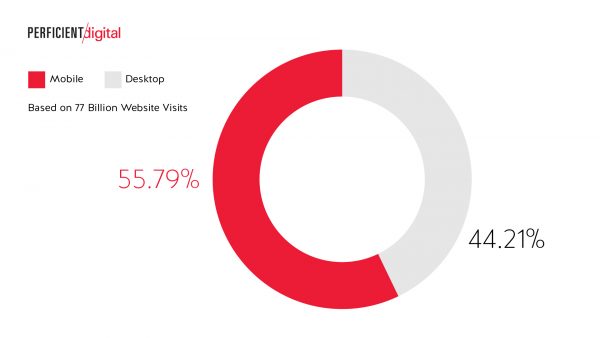
Mobile has established a clear lead. Chances are that this will continue to grow over time.
[Tweet “According to @similarweb Mobile now drives 56% of all traffic. More at”]
But, is that the whole story? Let’s dig a bit deeper to see, first by looking at total time on site:
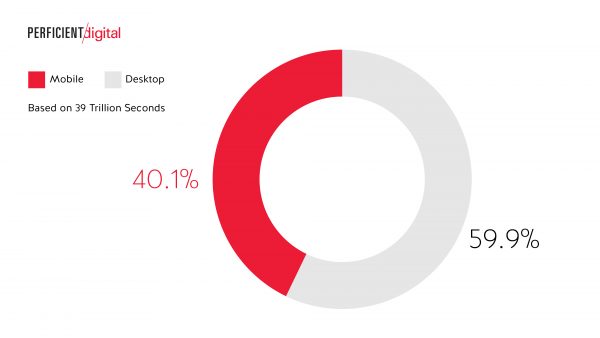
The above chart shows that people still spend more time on sites via a desktop computer than a mobile device. Note that this chart calculated the aggregate time of all visits tracked by SimilarWeb for a month, based on a cumulative total measured time of 39 trillion seconds.
[Tweet “Mobile drives more traffic worldwide, but desktop users spend more time on site. More at”]
Since our first chart showed that more visits came from mobile devices, this suggests that the average time per visit is significantly higher for desktop over mobile. In fact, our data shows that people spend about 1.9 times as much time per visit on desktop than they do on mobile.
Now let’s look at how the bounce rate differs:
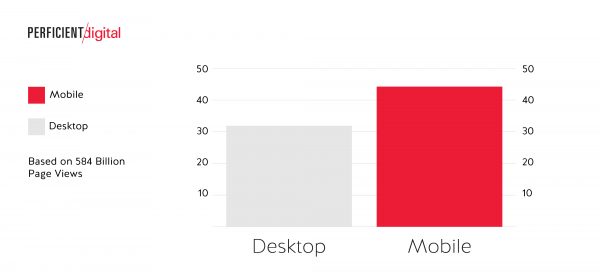
Another strong win for the desktop platform. In aggregate across the web, mobile bounce rates are 40% higher than they are on desktop.
[Tweet “Mobile drives more traffic, but has 40% higher bounce rate across the web according to @similarweb”]
One last stat to consider is that of total page views per visitor. This should help us understand another aspect of how the users engage in desktop vs. mobile:
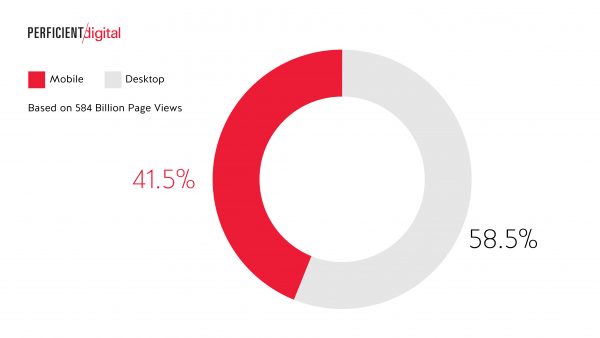
As you can see, desktop wins again. Looking at the entire web at this very broad level, what we see if that mobile devices generate the most visits, but that desktop sites still drive the most engagement.
[Tweet “Globally, mobile drives the most traffic, but desktop still wins for site engagement. More at”]
For most businesses, active participation across all device types is likely critical. Yet, it’s important to recognize the difference in how users behave based on the device they use to access your site and to adapt your strategy accordingly.
Stats by Industry Category
We also broke the data down by industry category, to see what level of variance we might see. In fact, the level of variance was very significant. Let’s start with a look at total visits again:
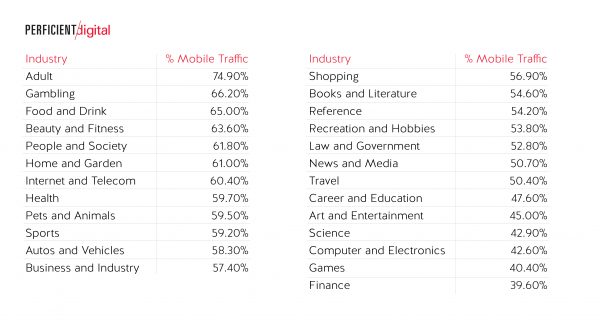
The variance is huge, with 75% of visits to adult sites coming from mobile devices, but just under 40% for the finance industry. In fact, there were six industries where more than half the visits still come from desktop devices. In contrast, there are seven industries where more than 60% of the visits come from mobile devices.
Next up, let’s look at time on site by industry category:
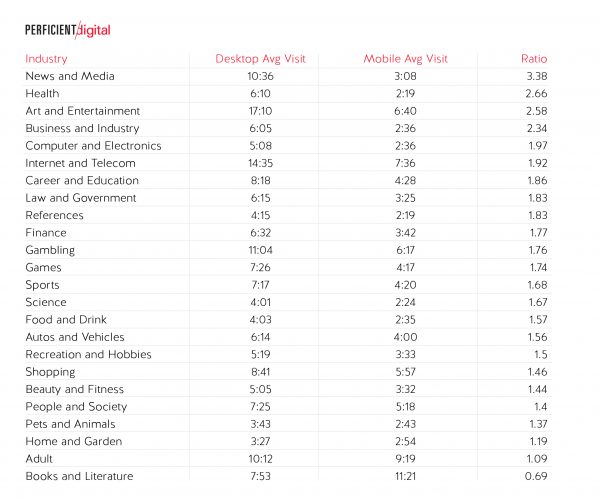
For this one, note the last column, where we calculate the ratio of desktop time on site to mobile time on site. The data shown is for the average time on site per visit.
For news and media we see that people spend 3.38 times longer on an average desktop visit than an average mobile visit. There is only one category where the average visit time is longer on mobile than desktop, books, and literature. The reason for this may be due to devices like the Kindle. There were two categories where the time was close to equal (Adult and Home and Garden).
Let’s look at bounce rate next:
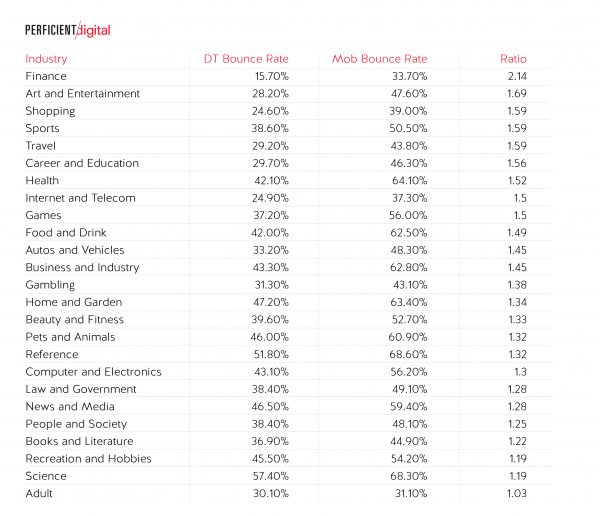
The bounce rate was higher on mobile for ALL 25 industries, though the Adult industry was close to dead even. In the finance sector, the bounce rate on mobile was more than twice as high.
Last, but not least, let’s look at page views per visitor:
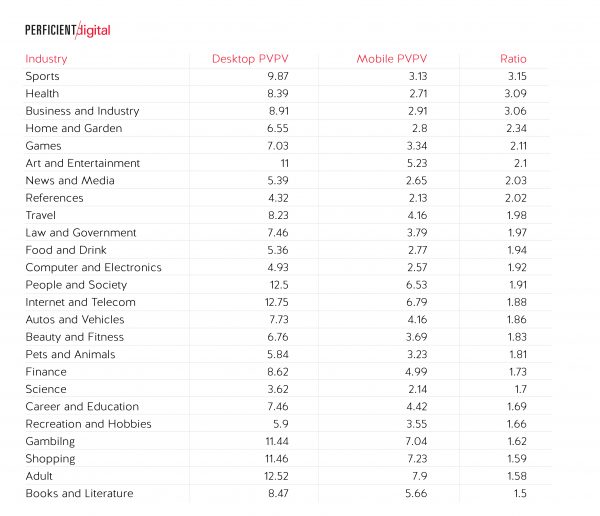
The desktop page views per visitor is clearly higher in every industry, ranging from 1.5 to 3.15 times higher.
Recommendations
How can we use this data to inform our digital marketing strategy? Some of the top observations and ideas I have are as follows:
Mobile Deserves a Full Seat at the Table: Historically, mobile was something we did as an offshoot of our desktop site. When desktop was the main platform, that probably made sense. But now, with anywhere between 40% to 75% of your visitors coming from mobile, you can no longer treat your mobile site as a secondary priority.
To me, this means designing your mobile site before you design the desktop site. Instead of coding your desktop site and then writing style sheets to shrink it into a Smartphone form factor, consider instead designing your mobile site first. Then you can figure out how to leverage the larger screen real estate available on a desktop platform.
In my estimation, this is more likely to lead to a high-quality user experience for both environments.
Don’t Forget to be Mobile First: While this was not the focus of this post, I feel I must remind you that sometime this year Google will switch to basing their rankings on their crawl of mobile sites, and not their crawl of desktop sites. That means you need to make SEO considerations a big part of what you do when putting together your mobile site. In a forthcoming study, I’ll be sharing data on what we’ve seen when crawling many different mobile sites.
Spoiler alert: it’s not good. Many of the mobile sites we checked were very poorly optimized for SEO.
Don’t Forget the Desktop!: Data shows that most conversions still happen there, so your desktop experience is still critical to overall business success. Paying more attention to mobile does NOT mean that you should ignore the desktop.
Consider Deferred Conversions: Given the characteristics of desktop vs. mobile, you may want to consider “micro conversions” in mobile, e.g., doing something simple, such as getting a user’s email address, and then following up with email outreach to try to bring them back on a desktop to convert them there.
The rationale for this is that users may not want to deal with complicated forms on a mobile device, and/or may not want to enter their credit card there. Following up with them later lets them come back on a desktop device and convert at a later, and perhaps more convenient time.
If you’re open to this idea, I’d urge you to test it thoroughly to see which gets better results for you.
Take Your Industry into Account: Of course, each industry is different, so take this into account as you move forward. If you’re in Finance, for example, only 40% of your visitors come from mobile devices. That’s still a large number, but it does suggest that you might be more conservative than other industries. And for example, your results with deferred conversions may be better than that in some other industries.
Compare Your Site’s Behavior to Industry Norms: If the average percentage of mobile visitors in your industry is 60%, and your site is at 35%, that may be an indicator of a problem. See how you compare to industry norms, and if there is a large delta with your site take the time to understand why.
Learn more about mobile digital marketing
- 31 Must Know Stats About the Continuing Growth of Voice Commands with Smartphones
- Why Mobile First Means Thinking Beyond the Browser
- Shopping and Finance Apps: What Do People Care About Most?
- Everything Mobile with Google’s John Mueller and Mariya Moeva
Want to keep learning? Check out all of our digital marketing research studies.



First to thank Eric for this informative and unique post.
Mobiles and desktop both are different devices but not completely. According to me in last few past years, mobiles phones and especially smart mobiles phones reach all over the world and serve a basic need for everybody, but it is also true that desktop is still a big player as compared to mobiles phone now.
Yes, mobile is diverting its traffic from desktop, as mobile is easy to carry anywhere, but desktop gives us the comfortability of viewing. So both desktop and mobile are getting good traffic, but in future mobile will definitely overcome the desktops.
Thanks Eric for the stats , This is really a very cool competition between mobile and desktop . I had no doubt in mind that the most searches from mobile are going to be for the adult industry and you see the desktop beating the mobiles in the page views and the bounce rates in most of the industries that is because the users does not explore much in the website with their mobiles they are just using mobiles because it is easy to be connected with them . Still desktops are clear winners.
*Editor: Post edited to replace profane words with SFW equivalents
Mobile phones are a poor interface for consuming content. I feel sorry for anyone watching movies on their phone for instance. Forget about email or anything work related, phones are a joke and only idiots use them to do work. The fact that sites such as Instagram don’t even allow you to post from a desktop site just goes to show how retarded and pretentious mobile first companies have become.
Now you literally have to have someone in the office messing around with cell phones all day long to manage your social media strategy… its borderline torture. Why can’t we just give them a mouse and keyboard? Oh yeah, you can’t even use a mouse with these devices, nor can you connect them to a monitor… Now the new iPhone is going to cost $1200 and people are going to pay it. That’s what is sad.
Desktop has fallen off a cliff in terms of interest and its still a better option for most serious uses of a computer. Some people think desktop is going to die off, I can assure you it won’t. Mobile has made impressive strides in computing power but what you can do with a battery you can do better with real power from the wall.
Plus, think about the batteries for once, nobody recognizes the danger, they’re packed with energy, the more densely packed they get, the more dangerous they get. Yeah, they may be totally safe for normal use, but what about intentional misuse? If you can release that energy fast enough you have a bomb. Bottom line mobile devices have limits. Battery limits. Screen limits. Portability limits. Annoyance limits. Privacy limits.
Don’t get me wrong, I think mobile is great, but I think mobile first is completely off the mark. We need to focus on what makes mobile great instead of trying to make everything into a mobile app. Yeah, some people are happy doing work typing stuff out with their thumbs, but those people are probably brain damaged from all the cell phone radiation… As an industry we need to focus on real use cases for mobile and not fantasies.
Hi Shawn – I agree that mobile devices have limits much like you say. And, I agree, desktop is not going away. If I’m researching something critical to me, I want the keyboard and a bigger screen. Even when voice replaces keyboards in more and more places, I’ll still want a bigger screen.
On what time span is this research based? From what date to what date?
March 2017
Wonderful post from eric.congrats dude 🙂
Great stuff on this site. Although I’d love to see breakdown including social media sites as a category. My sense is that engagement is very different.
I believe that the higher bounce rates and shorter engagement times are direct results of poor mobile web design. I don’t believe desktops will ever go away, but mobile is the future and companies and organizations that don’t realize that and still expect people to rely predominantly on their desktop design and don’t take seriously a mobile first strategy are going to lose out.
Hi Eric, great and thanks. Is it a worldwide statistic? Bests!
Hi Shawn,
I totally agree with you when thinking desktop vs mobiles as working/entertainment tools. But if you think it from a brand perspective, you have to really think what device should be first. Depending on your industry, awareness and engagement phases should take this statistic into account. Bests!
This is based on US traffic. We’ll do a new study in a few months, and we will include a worldwide view as well.
Thanks for sharing the list man, it’s probably gonna help a lot of SEOs and newbies to get some Do Follow backlinks for their domains.